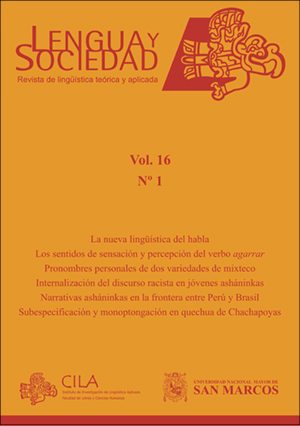Asháninca narratives and their processes on the border between Brazil and Peru
DOI:
https://doi.org/10.15381/lengsoc.v16i1.22385Keywords:
Ashaninca, Ethnography, CosmologyAbstract
This article discusses the narratives and representations the some experiences that the tribe Asháninca that live in Brazil. The myths are complex and also the processes that the Asháninca are developing for the understanding of the phenomena in their daily life. We focus our attention on the context of some of his knowledge, particularly those referring to his cosmology, which integrates viewpoints of many worlds, mixing fantastic figures and supernatural appearances with the presentation of some representation of the narrated versions of Its history and the knowledge acquired also through the master plants in their habitat: the border region of the forest between Brazil and Peru.
References
Leenhardt, M. (1971). Do Kamo, la personne et le mythe dans le monde mélanésien. Gallimard, Paris.
Lévi-Strauss, C. (1978;1989). Mito e Significado. Edições 70, Lisboa.
Lévi-Strauss, C. (1970; 1983; 1988; 1989). O Pensamento Selvagem. Papirus Editora/ Companhia Editora Nacional, Campinas/ São Paulo.
Metraux, A. (1973). Religión y magias indígenas de América del Sur. Ed. Aguilar, Madrid.
Mesquita, E. (2012). Ver de perto pra contar de certo: as mudanças climáticas sob os olhares dos moradores da floresta do Alto do Juruá. Tese doutorado, mimeo, UNICAMP, Campinas.
Pollock, D. (1992). Culina shamanism: gender, power and knowledge. In: E. Jean Langdon & G. Bear (orgs.). Portals of Power: shamanism in South America. Albuquerque: University of New Mexico Press. pp. 25-40, USA.
Renard-Casevitz, F. M. (1998). Ideologia Matsiguenga: entre lo local e lo Global, Año XVII, n 17, PUCP, Lima.
Romani, M. M. (2004). La toponímia en el Gran Pajonal con especial atención a los topónimos de filiación asháninka. Universidad San Marcos. Dissertación in Linguística. mimeo, Lima.
Jacintos Santos, P. E. (2009). Expresiones orales iconográficas en el guerrero arawak-asháninka. Perú, USMA, Lima.
Varese, S. (1968). La sal de los cerros. Notas etnográficas e historia sobre los campos de la selva del Perú. Lima. Universidad Peruana de Ciencias y Tecnología. Lima.
Viveiros De Castro, E. (2004). Perspectivismo e multinaturalismo na América Indígena, o que nos faz pensar; n 18, setembro, São Paulo.
Zolezzi, E. R. (1986). Los Ashaninka, un pueblo tras el bosque. Contribución a la etnología de los Campa de la Selva Central. Ed. PUCP. Lima.
Zolezzi E. R. (1996). Los ciclos de Pachakama, Inka y Sacramento en la mitología campa-asháninka como interpretaciones de los procesos de reemplazo tecnológico y subordinación económica surgidos de la colonización. In: Anthropológica. PUCP; Vol. 11; pp.109-154, Lima.
Zolezzi, E. R. (1997). Los Asháninkas: Un pueblo tras el bosque. Contribución a la etnología de los campos de la selva central. Universidad Católica del Perú, Lima.
Zolezzi, E. R. (1999). Origen y clasificación de las plantas cultivadas en el pensamiento mítico asháninka. Antropológica ,15. pp. 255-288. Lima.
Weiss, G. (1969). Campa Cosmology. The world of a forest tribe in South America. Anthropological Papers of the American Museum of Natural History. New York.
Downloads
Published
Issue
Section
License
Copyright (c) 2017 Érika Mesquita

This work is licensed under a Creative Commons Attribution 4.0 International License.
AUTHORS RETAIN THEIR RIGHTS
a. Authors retain their trade mark rights and patent, and also on any process or procedure described in the article.
b. Authors can submit to the journal Lengua y Sociedad, papers disseminated as pre-print in repositories. This should be made known in the cover letter.
c. Authors retain their right to share, copy, distribute, perform and publicly communicate their article (eg, to place their article in an institutional repository or publish it in a book), with an acknowledgment of its initial publication in the journal Lengua y Sociedad.
d. Authors retain theirs right to make a subsequent publication of their work, to use the article or any part thereof (eg a compilation of his papers, lecture notes, thesis, or a book), always indicating its initial publication in the journal Lengua y Sociedad (the originator of the work, journal, volume, number and date).






